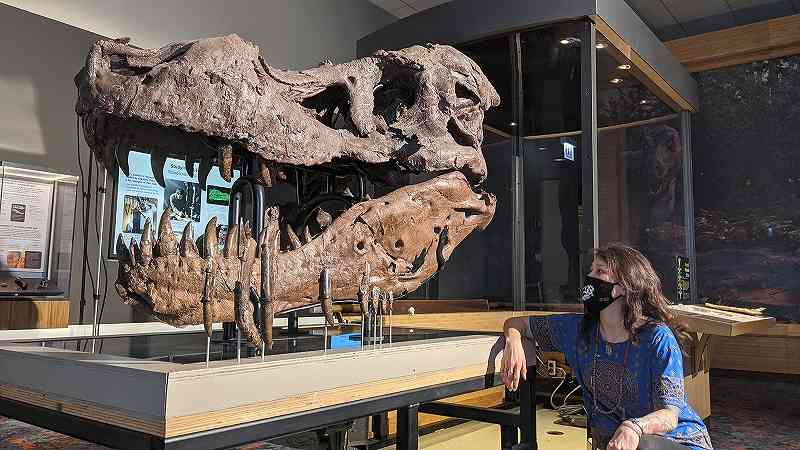
The fossil skull of a T. rex known as Sue is seen in this undated photo, obtained on Sept. 30.
17:17 JST, October 19, 2022
WASHINGTON (Reuters) — Sue, the biggest and best preserved Tyrannosaurus rex ever unearthed, no doubt was a fearsome beast when this predator prowled what is now South Dakota about 67 million years ago at the twilight of the age of dinosaurs.
But even this huge dinosaur, whose fossils are displayed at the Field Museum in Chicago, was not invulnerable. A prime example of this is the series of circular holes in Sue’s jawbone that continue to baffle scientists. New research seeking an explanation for these holes has managed to rule out one major hypothesis, though the answer remains elusive.
Researchers said a close examination of the eight holes — some the diameter of a golf ball — on the back half of Sue’s left lower jawbone, or mandible, determined that they were not caused by a type of microbial infection as some experts had proposed.
The holes were found to differ from bone damage caused by such an infection, said Bruce Rothschild, a medical doctor and research associate at the Carnegie Museum of Natural History in Pittsburgh, and lead author of the study published recently in the journal Cretaceous Research.
Sue, measuring 12.3 meters, represents one of the world’s best-known dinosaur fossils. Tyrannosaurus was one of the largest land predators ever, inhabiting western North America at the end of the Cretaceous Period.
Field Museum paleontologist and study coauthor Jingmai O’Connor noted that about 15% of all known T. rex specimens have holes similar to Sue’s.
The researchers explored whether the holes had been caused by an infection involving microbes called protozoans. One common protozoan disease known to occur in birds, which evolved from feathered dinosaurs, as well as in people is called trichomoniasis, caused by a parasitic protozoan. Trichomoniasis in people, though not birds, is a sexually transmitted disease.
O’Connor noted that one falcon diagnosed with trichomoniasis had shown damage in its jaw, but it differed from Sue’s holes.
The bone around Sue’s holes showed signs of healing, indicating that whatever caused them did not kill the animal. Similarities were observed between Sue’s healing and the healed breaks in other fossilized bones as well as healing bone seen around holes made in the skulls of ancient Inca people in Peru.
The cause of Sue’s holes remains a puzzle.
Rothschild proposed the possibility of claw damage during mating, or as he put it: “mounting from back or top with claws striking the posterior mandible.” Sue has a feminine name — honoring the woman who discovered the fossils in 1990 — but the dinosaur’s sex is unknown.
“I honestly have no clue what formed them,” O’Connor said. “I really do not think they are bite marks or claw marks.”
“A pathology that commonly affected T. rex individuals, that caused large holes to open up in the jawbone but only in the back of the jawbone, but didn’t kill the T. rex because the holes started to heal, at least in Sue — it’s weird,” O’Connor added. “So many hypotheses have been put forth only to be shot down. It’s a good paleontology mystery — my favorite.”
"Science & Nature" POPULAR ARTICLE
-

Genome Study Reveals Milestone in History of Cat Domestication
-

Big Leap in Quest to Get to Bottom of Climate Ice Mystery
-

Security Camera Footage Vulnerable to Outside Access; Investigation Finds 3,000 Pieces Exposed Online
-

Japan Set to Participate in EU’s R&D Framework, Aims to Boost Cooperation in Tech, Energy
-

Paws on Parade: Nairobi’s Dogs Dazzle at ‘Pawchella’
JN ACCESS RANKING
-

Tokyo Economic Security Forum to Hold Inaugural Meeting Amid Tense Global Environment
-

Keidanren Chairman Yoshinobu Tsutsui Visits Kashiwazaki-Kariwa Nuclear Power Plant; Inspects New Emergency Safety System
-

Imports of Rare Earths from China Facing Delays, May Be Caused by Deterioration of Japan-China Relations
-

University of Tokyo Professor Discusses Japanese Economic Security in Interview Ahead of Forum
-

Japan Pulls out of Vietnam Nuclear Project, Complicating Hanoi’s Power Plans






















